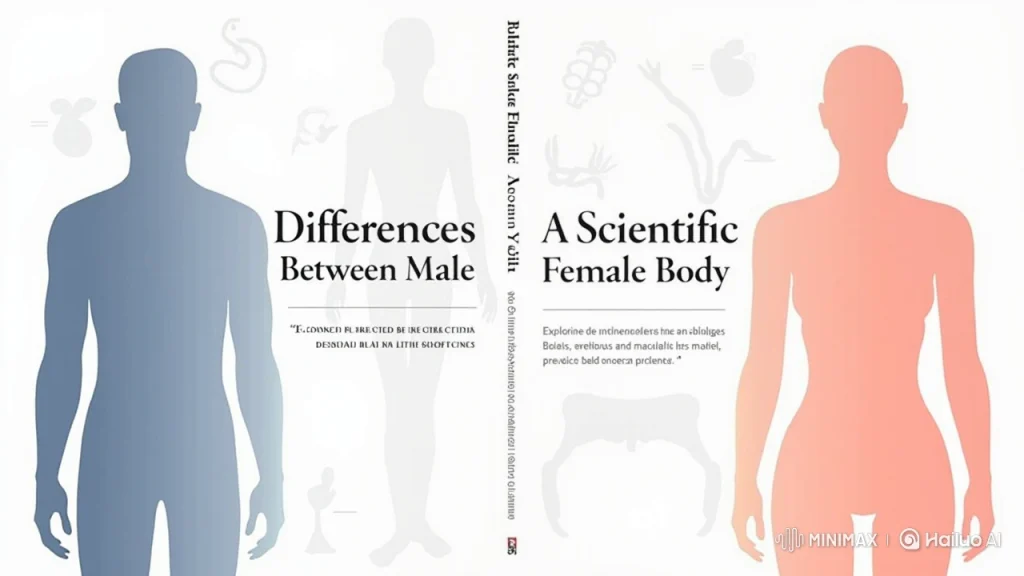Physical Address
304 North Cardinal St.
Dorchester Center, MA 02124
Physical Address
304 North Cardinal St.
Dorchester Center, MA 02124

Understanding the differences between the male and female body is crucial not only in the medical field but also in various other disciplines such as psychology, physical education, and nutrition. This article explores the biological and physiological differences between the sexes.

One of the most evident differences between the male and female body is the bone and muscle structure. Men tend to have larger bones and more muscle mass compared to women. On average, men have approximately 40 – 50% more muscle mass than women, a significant portion of which can be attributed to higher levels of testosterone in men. Testosterone, often referred to as the “male hormone,” stimulates muscle protein synthesis, which in turn promotes muscle growth and also increases bone density. A study published in the Journal of Clinical Endocrinology & Metabolism found that men with higher testosterone levels had greater lean body mass and stronger bones.
Muscle growth in men is further facilitated by a higher concentration of type II muscle fibers, responsible for fast and powerful contractions. These fibers are well – adapted for activities such as sprinting and weightlifting. In contrast, women have a relatively higher proportion of type I muscle fibers, which are more suited for endurance activities like long – distance running.
Women, on the other hand, have a higher amount of body fat compared to men, which is distributed differently across the body. On average, women have about 10 – 12% more body fat than men. Areas such as the hips and thighs tend to be more prominent in women due to the effects of estrogen, which influences fat distribution. Estrogen stimulates the storage of fat in these areas, which may have evolutionary advantages related to childbirth and energy reserve during pregnancy. Additionally, women have lower bone density than men, making them more susceptible to conditions like osteoporosis, especially after menopause. A research review showed that postmenopausal women have a 3 – 5 times higher risk of osteoporotic fractures compared to men of the same age. The distribution of body fat in women is also influenced by leptin, a hormone produced by adipose tissue that regulates appetite and metabolism. Leptin levels in women can fluctuate significantly during the menstrual cycle, affecting food intake and energy expenditure.

The most obvious and significant difference between male and female bodies lies in the reproductive system. Men have reproductive organs such as testes, which produce sperm and male hormones like testosterone. A healthy adult male can produce millions of sperm cells daily, with each sperm having the potential to fertilize an egg. The testes are also responsible for the production of testosterone, which plays a vital role in male sexual development and secondary sexual characteristics.
Women have a reproductive system that includes ovaries, a uterus, and fallopian tubes, responsible for producing eggs and female hormones such as estrogen and progesterone. The ovaries contain thousands of immature eggs at birth, and during each menstrual cycle, one or more eggs may mature and be released in a process called ovulation. The fallopian tubes serve as the pathway for the egg to travel from the ovary to the uterus, and it is in the fallopian tubes that fertilization usually occurs if sperm are present.
The female menstrual cycle is a unique and complex aspect of the reproductive system, regulated by a delicate balance of hormones. This cycle typically lasts around 28 days and involves the thickening of the uterine lining in preparation for a potential pregnancy. If pregnancy does not occur, the uterine lining is shed, resulting in menstruation. This cycle affects not only reproductive capability but also various aspects of overall health in women, such as bone density and metabolism. For example, estrogen levels during the menstrual cycle can influence calcium absorption, thereby impacting bone health. During pregnancy, hormonal and physical changes in women are even more pronounced, with increased levels of hormones like hCG (human chorionic gonadotropin), progesterone, and estrogen, which support fetal growth and development. hCG, produced by the developing placenta, is the hormone detected in pregnancy tests, while progesterone helps maintain the uterine lining and suppresses uterine contractions to prevent premature labor.

Hormones play a crucial role in the differences between male and female bodies. Men produce higher amounts of testosterone, which affects muscle mass, bone density, and behaviors typically associated with masculinity, such as aggression and competitiveness. Testosterone levels in men peak during adolescence and early adulthood, contributing to rapid muscle growth, voice deepening, and the development of facial and body hair. A meta – analysis of multiple studies found that higher testosterone levels in men were associated with increased dominance – seeking behaviors in social settings.
Women, on the other hand, produce more estrogen and progesterone, hormones that regulate the menstrual cycle and influence various aspects of female health, such as bone density and fat distribution. Estrogens have a protective role against certain cardiovascular diseases until menopause. Before menopause, estrogen helps maintain healthy cholesterol levels by increasing high – density lipoprotein (HDL, the “good” cholesterol) and decreasing low – density lipoprotein (LDL, the “bad” cholesterol). After menopause, the decrease in estrogen levels can increase the risk of cardiovascular diseases in women, as cholesterol profiles may worsen. Estrogens also influence mood and may play a role in modulating stress responses and preventing depression. Research has shown that fluctuations in estrogen levels during the menstrual cycle can affect neurotransmitter systems in the brain, potentially leading to mood swings and increased vulnerability to depression in some women.

Another significant difference between men and women concerns metabolism. Men tend to have a higher basal metabolic rate (BMR) compared to women, meaning they burn calories more quickly. On average, men’s BMR is about 5 – 10% higher than that of women. This is partly due to the greater muscle mass in men, which requires more energy to maintain. Muscle tissue is more metabolically active than fat tissue, so the higher proportion of muscle in men contributes to their increased calorie – burning capacity. Most of the muscle mass in men is composed of type II muscle fibers, which are metabolically more active than type I fibers, predominantly present in women.
Women generally have a lower BMR and tend to store more body fat, which can be an evolutionary advantage for energy conservation. However, these metabolic differences can influence how men and women respond to diet and exercise, requiring personalized approaches for weight management and metabolic health. For example, studies have shown that women tend to use fats as the primary energy source during low – intensity exercise, while men tend to use more carbohydrates. This difference in fuel utilization means that women may benefit from longer – duration, lower – intensity workouts to burn fat effectively, whereas men might see better results from shorter, high – intensity exercises that target carbohydrate – based energy systems.

The cardiovascular system also shows some differences between the sexes. Men tend to have larger hearts and lungs, allowing for greater oxygen transport capacity and increased physical endurance. The average male heart is about 10 – 15% larger than the female heart, and men typically have a higher maximum oxygen uptake (VO2 max), which is a measure of the body’s ability to use oxygen during exercise. This gives men an edge in activities that require sustained physical effort, such as long – distance running or cycling.
Women, on the other hand, are generally more resistant to fatigue and can recover more quickly after physical exertion, thanks to a cardiovascular system that is more efficient in terms of blood distribution during exercise. Additionally, women have greater arterial elasticity, which can contribute to lower blood pressure compared to men. A study on arterial stiffness in men and women found that women had more compliant arteries, which helps maintain healthy blood flow and reduces the workload on the heart. However, this elasticity decreases with age and after menopause, increasing the risk of hypertension and other cardiovascular diseases. Estrogens play a protective role in women by improving endothelial function (the inner lining of blood vessels) and reducing vascular inflammation.

Differences between the sexes are not limited to physical aspects but also extend to cognitive and psychological ones. Neuroscientific studies have shown variations in brain structure and function between men and women. For example, women tend to have greater connectivity between brain hemispheres, which may contribute to enhanced multitasking and communication abilities. This inter – hemispheric connectivity is thought to facilitate the integration of different types of information, such as language and emotion, allowing women to be more attuned to social cues.
Men, on the other hand, show stronger connectivity within hemispheres, associated with better spatial orientation and motor coordination. This intra – hemispheric connectivity enables men to excel in tasks that require spatial reasoning, such as navigation and mechanical problem – solving. Differences in levels of sex hormones also influence the brain. Estrogens, for instance, have neuroprotective effects and can enhance cognitive functions in women. Research has demonstrated that estrogen can promote the growth of new neurons and synapses in the brain, improving memory and learning abilities. Testosterone in men is associated with dominance and aggressive behaviors, as well as a greater propensity for risk – taking. In animal studies, testosterone administration has been shown to increase territorial aggression and exploration behaviors, which may have parallels in human male behavior.
Sex differences also extend to the immune system. Women tend to have a more robust immune response compared to men, which may be due to higher levels of estrogen and progesterone. These hormones can modulate the immune system, increasing the production of antibodies and enhancing the activity of immune cells. For example, estrogen has been shown to stimulate the production of B – lymphocytes, which are responsible for producing antibodies. However, this stronger immune response can also make women more susceptible to autoimmune diseases, such as lupus and rheumatoid arthritis. Autoimmune diseases occur when the immune system mistakenly attacks the body’s own tissues, and women are disproportionately affected. Studies estimate that women are 2 – 3 times more likely than men to develop autoimmune diseases, likely due to the complex interactions between sex hormones and the immune system.
In conclusion, the differences between the male and female body are complex and multifaceted, influenced by a combination of genetic, hormonal, and environmental factors. Understanding these differences can help us better appreciate the unique characteristics of each sex and provide valuable insights for various fields, including medicine, fitness, and psychology. Whether it’s in the context of health, performance, or relationships, being aware of these distinctions can lead to more informed decisions and a deeper understanding of human biology.